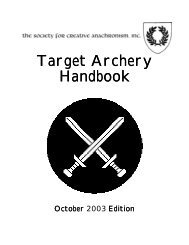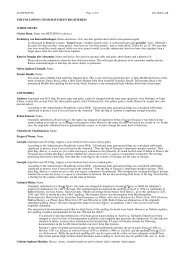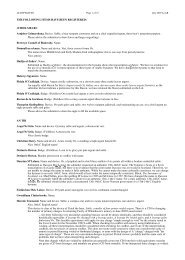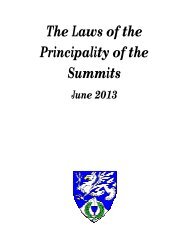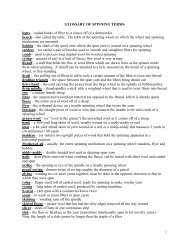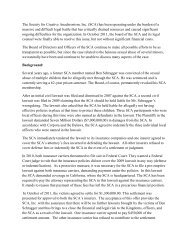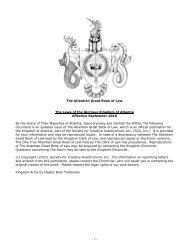<strong>The</strong> <strong>St<strong>and</strong>ards</strong> <strong>for</strong> <strong>Evaluation</strong> <strong>of</strong> <strong>Names</strong> <strong>and</strong> <strong>Armory</strong>:<strong>The</strong> Rules <strong>for</strong> SubmissionsNotes: Polish: In Polish, i/y/j switches are common, <strong>and</strong> the use <strong>of</strong> accents is inconsistent. <strong>Names</strong> will be registered with or without accents as long as they are consistent.In Polish, bynames based on relationships can be marked with Latinized particles or with their Polish vernacular equivalents, such as B syn 'B's son', B brat 'B's brother', Bżona 'B's wife', <strong>and</strong> B wdowa 'B's widow'. Alternately, the relationship could be indicated by a suffix added to their relative's name, such as Bwic(z)/Bwicc ('son <strong>of</strong> B') orByk/Bik ('little B', <strong>for</strong>ming a diminutive). Women's bynames use feminine <strong>for</strong>ms. Most frequently, patronyms are changed by adding the diminutive suffix –ina/-yna, orby adding–ówa (married name) or –ówna (maiden name), making Bina or Bówa. What look like double given names may well be unmarked patronymic bynames.Locative bynames in Polish-language documents normally take the preposition z/ze 'from/<strong>of</strong>', followed by the place name in the genitive case. Alternately, an adjectival<strong>for</strong>m can be created by adding –ski <strong>for</strong> men or –ska <strong>for</strong> women to the location's name in its grammatically required <strong>for</strong>m.Czech: All patterns in Czech must be documented. Academy <strong>of</strong> Saint Gabriel report 3244 (http://www.s-gabriel.org/3244.txt) gives some leads <strong>for</strong> documenting Czech<strong>for</strong>ms.Persian: Persian name structures are quite different from European name structures. All patterns found in Ursula Georges, "Persian Masculine <strong>Names</strong> in the Nafah.ât aluns"(http://www.s-gabriel.org/names/ursula/nafahat/) are registerable. <strong>The</strong> most common structure is a single given name followed by a locative byname derived fromthe adjectival <strong>for</strong>m <strong>of</strong> a placename (usually adding – î to the placename <strong>for</strong> both men <strong>and</strong> women). Descriptive bynames are also found. A few examples <strong>of</strong> women'sbynames (all locative) can be found in Aryanhwy merch Catmael <strong>and</strong> Ursula Georges, "Persian Feminine <strong>Names</strong> from the Safavid Period" (http://www.sgabriel.org/names/ursula/persian.html).Romany: Romany are known to have used two names: a private name used only in their community, <strong>and</strong> a vernacular use name, used in interactions with locals. We donot currently have evidence <strong>of</strong> the elements or structure <strong>of</strong> private names be<strong>for</strong>e 1600; without such evidence they cannot be registered. In general, <strong>for</strong>ming a nameappropriate <strong>for</strong> the desired region/language where a Romany persona is living (e.g., "A from X") follows period usage.Russian/East Slavic: All patterns found in Paul Wickenden <strong>of</strong> Thanet's "A Dictionary <strong>of</strong> Period Russian <strong>Names</strong>" (http://heraldry.sca.org/paul/) <strong>and</strong> "Locative Bynamesin Medieval Russia" (http://heraldry.sca.org/laurel/names/toprus.html) are registerable.RussianDoubleGiven<strong>Names</strong>Yes; oneChristian,one SlavicLocative Patronymic OtherrelationshipAdjectival,rarely other<strong>for</strong>msOther (see notes)Marked (seenotes)Matronymics,wifeDescriptive/OccupationalDictus Double Bynames OrderYes Yes; multiple patronymics(or patronymic from father'swhole name)(see notes)Notes: Russian: <strong>The</strong> construction <strong>of</strong> Russian bynames is complicated; see Paul Wickenden <strong>of</strong> Thanet's "A Dictionary <strong>of</strong> Period Russian <strong>Names</strong>"(http://heraldry.sca.org/paul/) <strong>for</strong> structures both <strong>of</strong> individual bynames <strong>and</strong> <strong>for</strong> names as a whole. His <strong>and</strong> "Locative Bynames in Medieval Russia"(http://heraldry.sca.org/laurel/names/toprus.html) is also useful <strong>for</strong> constructing locative bynames.Other East Slavic languages, like Ukranian <strong>and</strong> Belorussian, follow similar patterns to Russian; they must generally be documented individually.Rules <strong>for</strong> Submissions - January, 2012
Sc<strong>and</strong>inavianOld Norse/Old Icel<strong>and</strong>icSwedish,Danish,Finnish,Norwegian,Icel<strong>and</strong>ic, etc.DoubleGiven<strong>Names</strong>No<strong>The</strong> <strong>St<strong>and</strong>ards</strong> <strong>for</strong> <strong>Evaluation</strong> <strong>of</strong> <strong>Names</strong> <strong>and</strong> <strong>Armory</strong>:<strong>The</strong> Rules <strong>for</strong> SubmissionsLocative Patronymic OtherrelationshipPhrase,adjectival;see notesPhrase,adjectival;see notesMarked; -son or-dóttir added tothe genitive <strong>of</strong>father’s nameMarked; Bson orBsen usinggenitive <strong>of</strong>father’s name; seenotes <strong>for</strong> feminineTwo-generationpatronymic;Bson Csonar,wife (Bkona)Wife (using thegenitive <strong>for</strong>m <strong>of</strong>the husb<strong>and</strong>'sname)Descriptive/OccupationalDescriptive,occupational arerareDictusDoubleBynamesDescriptivebyname +patronymic ortwo-generationpatronymicOrderRare given+bygiven+bygiven+descriptive+patgiven+pat+descriptivegiven+pat+patNotes: For Old Norse/Old Icel<strong>and</strong>ic, see Geirr Bassi Haraldsson's <strong>The</strong> Old Norse Name <strong>and</strong> Lindorm Eriksson's "<strong>The</strong> Bynames <strong>of</strong> the Viking Age Runic Inscriptions".See Lindorm's article <strong>for</strong> more in<strong>for</strong>mation on locative bynames.Accents <strong>and</strong> other diacritics (like þ, ð, <strong>and</strong> {o,}) may be used or omitted, as long as the system is consistent; see Appendix D <strong>for</strong> more details.For Old Norse/Old Icel<strong>and</strong>ic, by precedent, prepended bynames (nicknames that precede the given name) are capitalized, but nicknames that follow the given name arenot.For later Sc<strong>and</strong>inavian languages (Swedish, Danish, Finnish, Norwegian, Icel<strong>and</strong>ic, etc., the feminine <strong>for</strong>ms <strong>of</strong> patronymics are variable. Swedish <strong>for</strong>ms include Bdotter,Bdotther, Bdottir, <strong>and</strong> Bdatter, while Danish <strong>for</strong>ms include Bdother, Bdotter, Bdaatter, Bdaater, <strong>and</strong> Bdaather. Other <strong>for</strong>ms must be documented.Locative bynames take the <strong>for</strong>m i X in Swedish, af X in Danish, <strong>for</strong> example. <strong>The</strong> placenames must be grammatically correct <strong>for</strong>ms to follow those prepositions..For details <strong>of</strong> construction in Swedish, see http://www.s-gabriel.org/2296. Swedish: Wife (using genitive <strong>for</strong>m <strong>of</strong> husb<strong>and</strong>'s given or full name)South Slavic (Serbian, Croatian, etc.): All patterns must be documented. Our sources <strong>for</strong> South Slavic names are quite limited. One useful source is Walraven vanNijmegen, "Early Croatian Given <strong>Names</strong>" (http://www.s-gabriel.org/names/walraven/croat/), which documents the pattern <strong>of</strong> a single given name followed by a singlepatronymic byname which is either the father's name unchanged or a construction <strong>for</strong>med by adding –ov, -ovic. Other sources suggest –ic may sometimes be used toconstruct a patronymic byname.Turkish: Turkish names are quite different from European names; they are somewhat like Arabic names, but do not follow all Arabic patterns. All patterns found inUrsula Georges, "Sixteenth-Century Turkish <strong>Names</strong>" (http://www.s-gabriel.org/names/ursula/ottoman/) are registerable.Rules <strong>for</strong> Submissions - January, 2012



